The Marine HVAC System Market is estimated to be valued at USD 3.4 billion in 2025 and is projected to reach USD 5.7 billion by 2035, registering a compound annual growth rate (CAGR) of 5.2% over the forecast period.
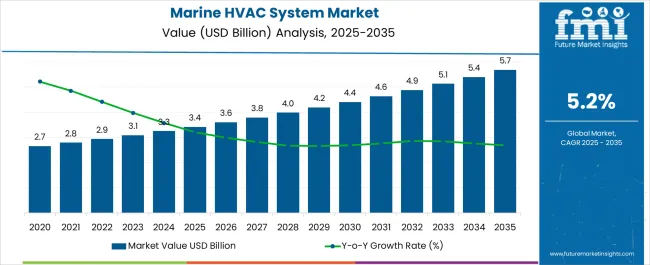
| Metric | Value |
|---|---|
| Marine HVAC System Market Estimated Value in (2025 E) | USD 3.4 billion |
| Marine HVAC System Market Forecast Value in (2035 F) | USD 5.7 billion |
| Forecast CAGR (2025 to 2035) | 5.2% |
The Marine HVAC System market is experiencing consistent growth, driven by the increasing demand for efficient heating, ventilation, and air conditioning solutions across commercial and passenger vessels. Rising emphasis on energy efficiency, operational reliability, and environmental compliance is encouraging adoption of advanced HVAC systems in marine applications. Modern vessels are being equipped with systems that optimize temperature, humidity, and air quality, ensuring comfort for passengers and crew while meeting regulatory standards for emissions and energy consumption.
Integration of smart controls, automation, and energy recovery technologies is enhancing system performance and reducing operational costs. The expansion of the global cruise and ferry industry, coupled with growing offshore operations, has increased the requirement for robust HVAC solutions capable of operating in challenging maritime environments.
Investments in vessel modernization and retrofitting programs further support market growth As environmental regulations and operational efficiency requirements become more stringent, the Marine HVAC System market is expected to witness sustained expansion, driven by technological innovation, intelligent system integration, and the growing need for reliable marine climate control solutions.
The marine hvac system market is segmented by type of vessel, type, area of application, technology, capacity, distribution, and geographic regions. By type of vessel, marine hvac system market is divided into Passenger Vessels, Service Vessels, Cruise Ships, Ferries, Cargo Carriers, Tankers, Container Ships, Bulk Carriers, Other Cargo Ships, Fishing Vessels, Personal Watercraft & Sailboats, and Others. In terms of type, marine hvac system market is classified into All Water Systems, All Air Systems (High Or Low-Pressure), Air-And-Water Systems, and Others. Based on area of application, marine hvac system market is segmented into Engine Room, Cargo Hold, Deck, Galley, Tender Garage, and Others. By technology, marine hvac system market is segmented into Marine Air Conditioning, Marine Ventilation Systems, Marine Heating Systems, and Marine Refrigeration Systems. By capacity, marine hvac system market is segmented into 11-100 RT, Less Than 10 RT, and More Than 100 RT. By distribution, marine hvac system market is segmented into Centralized, Decentralized, and Combined. Regionally, the marine hvac system industry is classified into North America, Latin America, Western Europe, Eastern Europe, Balkan & Baltic Countries, Russia & Belarus, Central Asia, East Asia, South Asia & Pacific, and the Middle East & Africa.
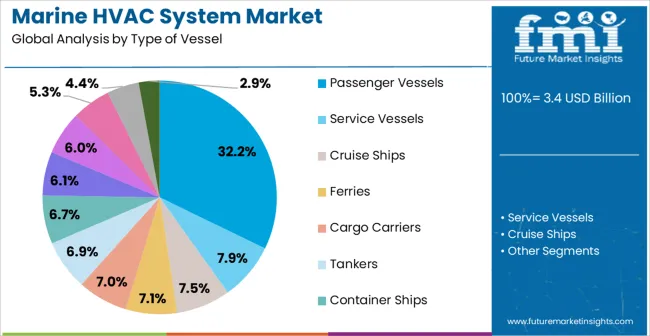
The passenger vessels segment is projected to hold 32.2% of the market revenue in 2025, establishing it as the leading vessel type. Growth is being driven by the increasing number of cruise ships, ferries, and other passenger vessels requiring advanced climate control to ensure passenger comfort and safety. HVAC systems in these vessels must maintain optimal indoor air quality, temperature, and humidity, despite varying external weather conditions and high occupancy loads.
The adoption of energy-efficient and low-maintenance solutions is being prioritized to reduce operational costs and comply with maritime environmental regulations. Integration with smart building management and automation systems allows real-time monitoring and adaptive control, enhancing system performance. Passenger vessels are also incorporating HVAC solutions to address noise reduction, vibration control, and space optimization requirements.
Continuous innovation in marine HVAC design, including compact modular units and corrosion-resistant components, supports the increasing demand for reliable and sustainable climate control systems As the global passenger vessel fleet expands and modernizes, the passenger vessels segment is expected to maintain market leadership.
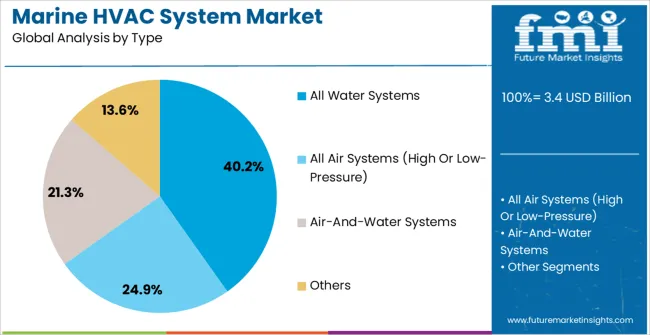
The all water systems segment is anticipated to account for 40.2% of the market revenue in 2025, making it the leading system type. Its growth is being driven by the ability to provide comprehensive heating, cooling, and ventilation functions using water as the primary medium, which enhances energy efficiency and reduces operational complexity. All water HVAC systems enable uniform temperature control, flexibility in zoning, and simplified maintenance, which are critical for marine environments.
Integration with energy recovery units and smart control systems further optimizes performance and minimizes energy consumption. The use of water as a heat transfer medium allows for safer operation in confined spaces, reducing fire hazards and supporting compliance with maritime safety standards.
Growing investments in energy-efficient marine infrastructure and vessel retrofitting programs are further supporting adoption As shipowners and operators prioritize reliable, scalable, and environmentally compliant climate control solutions, all water systems are expected to remain the preferred choice in marine HVAC applications, driving continued market growth.
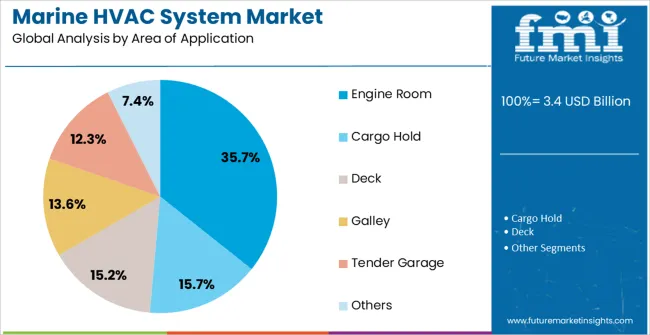
The engine room segment is projected to hold 35.7% of the market revenue in 2025, establishing it as the leading area of application. Growth is being driven by the critical need for effective heat and ventilation management in engine rooms to ensure operational efficiency, safety, and equipment longevity. Engine room HVAC systems maintain optimal temperature and humidity conditions, preventing overheating, corrosion, and equipment failure.
Integration with intelligent monitoring systems enables real-time performance tracking, fault detection, and adaptive control, which enhances safety and operational reliability. Energy-efficient designs reduce fuel consumption and contribute to overall vessel sustainability. As maritime operators increasingly adopt advanced propulsion systems and auxiliary equipment, the requirement for robust climate control solutions in engine rooms is intensifying.
Regulatory compliance with marine safety and emission standards further reinforces demand With the expansion of commercial and passenger fleets, coupled with technological innovations in HVAC components and control systems, the engine room segment is expected to sustain its leading position as a critical application area in the Marine HVAC System market.
As the climatic condition at oversea is relatively humid and warm so marine HVAC system is of great importance to control the on-board temperatures and humidity in any marine vessel, such as cruise ship, cargo ships, warship or offshore marine facility and platforms.
Moreover, as the humid surrounding degrades the efficiency of the people on board and also corrode the cargo, machinery, and equipment of the ship increasing the maintenance cost, to avoid this HVAC system become a necessity for the marine industry these days. HVAC system contributes a lot towards the maintenance of the fresh, clean air of desired temperature and humidity for the crew, passengers as well as machinery.
Marine HVAC systems are different from most of the land HVAC systems, as the marine HVAC systems are generally water cooled and not air cooled. It may be due to the fact that, on a ship, there is limited availability of space and abundance of water.
Moreover, in luxury ships such as cruise, the expectation of passenger is to have an experience of a lifetime. Which include high expectation towards the luxury and comfort and the indoor climate is part of the overall impression. In short, an effective HVAC system is a key contributor to the comfortable journey as well as successful vessel operation.
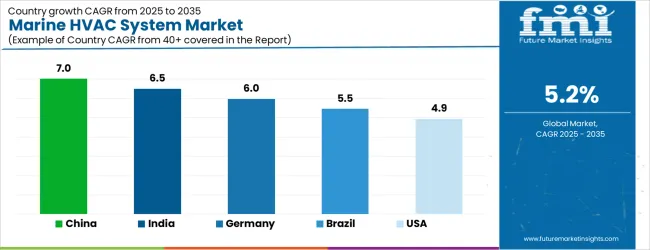
| Country | CAGR |
|---|---|
| China | 7.0% |
| India | 6.5% |
| Germany | 6.0% |
| Brazil | 5.5% |
| USA | 4.9% |
| UK | 4.4% |
| Japan | 3.9% |
The Marine HVAC System Market is expected to register a CAGR of 5.2% during the forecast period, exhibiting varied country level momentum. China leads with the highest CAGR of 7.0%, followed by India at 6.5%. Developed markets such as Germany, France, and the UK continue to expand steadily, while the USA is likely to grow at consistent rates. Japan posts the lowest CAGR at 3.9%, yet still underscores a broadly positive trajectory for the global Marine HVAC System Market. In 2024, Germany held a dominant revenue in the Western Europe market and is expected to grow with a CAGR of 6.0%. The USA Marine HVAC System Market is estimated to be valued at USD 1.2 billion in 2025 and is anticipated to reach a valuation of USD 1.2 billion by 2035. Sales are projected to rise at a CAGR of 0.0% over the forecast period between 2025 and 2035. While Japan and South Korea markets are estimated to be valued at USD 186.3 million and USD 97.8 million respectively in 2025.
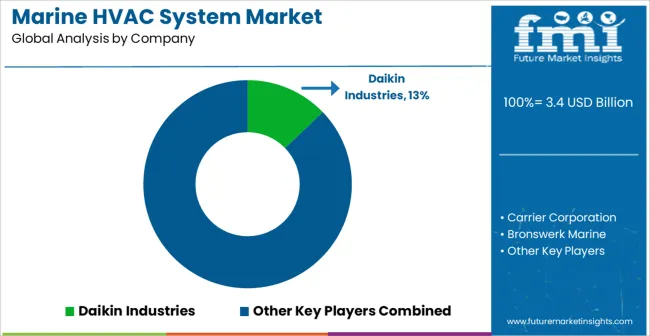
| Item | Value |
|---|---|
| Quantitative Units | USD 3.4 Billion |
| Type of Vessel | Passenger Vessels, Service Vessels, Cruise Ships, Ferries, Cargo Carriers, Tankers, Container Ships, Bulk Carriers, Other Cargo Ships, Fishing Vessels, Personal Watercraft & Sailboats, and Others |
| Type | All Water Systems, All Air Systems (High Or Low-Pressure), Air-And-Water Systems, and Others |
| Area of Application | Engine Room, Cargo Hold, Deck, Galley, Tender Garage, and Others |
| Technology | Marine Air Conditioning, Marine Ventilation Systems, Marine Heating Systems, and Marine Refrigeration Systems |
| Capacity | 11-100 RT, Less Than 10 RT, and More Than 100 RT |
| Distribution | Centralized, Decentralized, and Combined |
| Regions Covered | North America, Europe, Asia-Pacific, Latin America, Middle East & Africa |
| Country Covered | United States, Canada, Germany, France, United Kingdom, China, Japan, India, Brazil, South Africa |
| Key Companies Profiled | Daikin Industries, Carrier Corporation, Bronswerk Marine, Dometic Group, Johnson Controls, Frigomar, Horn Media Group, GEA Farm Technologies, AF Group, NADI Airtechnics, Kongsberg Maritime, TMD Marine, Webasto, Novenco, Marcotex, Ma Inc, and Heinen & Hopman |
The global marine hvac system market is estimated to be valued at USD 3.4 billion in 2025.
The market size for the marine hvac system market is projected to reach USD 5.7 billion by 2035.
The marine hvac system market is expected to grow at a 5.2% CAGR between 2025 and 2035.
The key product types in marine hvac system market are passenger vessels, service vessels, cruise ships, ferries, cargo carriers, tankers, container ships, bulk carriers, other cargo ships, fishing vessels, personal watercraft & sailboats and others.
In terms of type, all water systems segment to command 40.2% share in the marine hvac system market in 2025.






Full Research Suite comprises of:
Market outlook & trends analysis
Interviews & case studies
Strategic recommendations
Vendor profiles & capabilities analysis
5-year forecasts
8 regions and 60+ country-level data splits
Market segment data splits
12 months of continuous data updates
DELIVERED AS:
PDF EXCEL ONLINE
Marine Life Raft Market Size and Share Forecast Outlook 2025 to 2035
Marine Trenchers Market Size and Share Forecast Outlook 2025 to 2035
Marine Electronics Tester Market Size and Share Forecast Outlook 2025 to 2035
Marine & Dock Gangways Market Size and Share Forecast Outlook 2025 to 2035
Marine Outboard Engines Market Size and Share Forecast Outlook 2025 to 2035
Marine Stabilizers Market Size and Share Forecast Outlook 2025 to 2035
Marine Energy Market Size and Share Forecast Outlook 2025 to 2035
Marine Propulsion Engine Market Size and Share Forecast Outlook 2025 to 2035
Marine Protein Hydrolysate Market Size and Share Forecast Outlook 2025 to 2035
Marine Fin Stabilizer Market Size and Share Forecast Outlook 2025 to 2035
Marine Extract Market Size and Share Forecast Outlook 2025 to 2035
Marine Squalene Alternatives Market Size and Share Forecast Outlook 2025 to 2035
Marine Prebiotics Market Size and Share Forecast Outlook 2025 to 2035
Marine Collagen-Based Products Market Analysis - Size, Share, and Forecast Outlook 2025 to 2035
Marine Communication Market Size and Share Forecast Outlook 2025 to 2035
Marine Derived Proteins Market Size and Share Forecast Outlook 2025 to 2035
Marine Winch Motors Market Size and Share Forecast Outlook 2025 to 2035
Marine Biotech Ingredients Market Analysis - Size and Share Forecast Outlook 2025 to 2035
Marine Plankton Extracts Market Analysis - Size and Share Forecast Outlook 2025 to 2035
Marine Reciprocating Engine Market Size and Share Forecast Outlook 2025 to 2035

Thank you!
You will receive an email from our Business Development Manager. Please be sure to check your SPAM/JUNK folder too.
Chat With
MaRIA